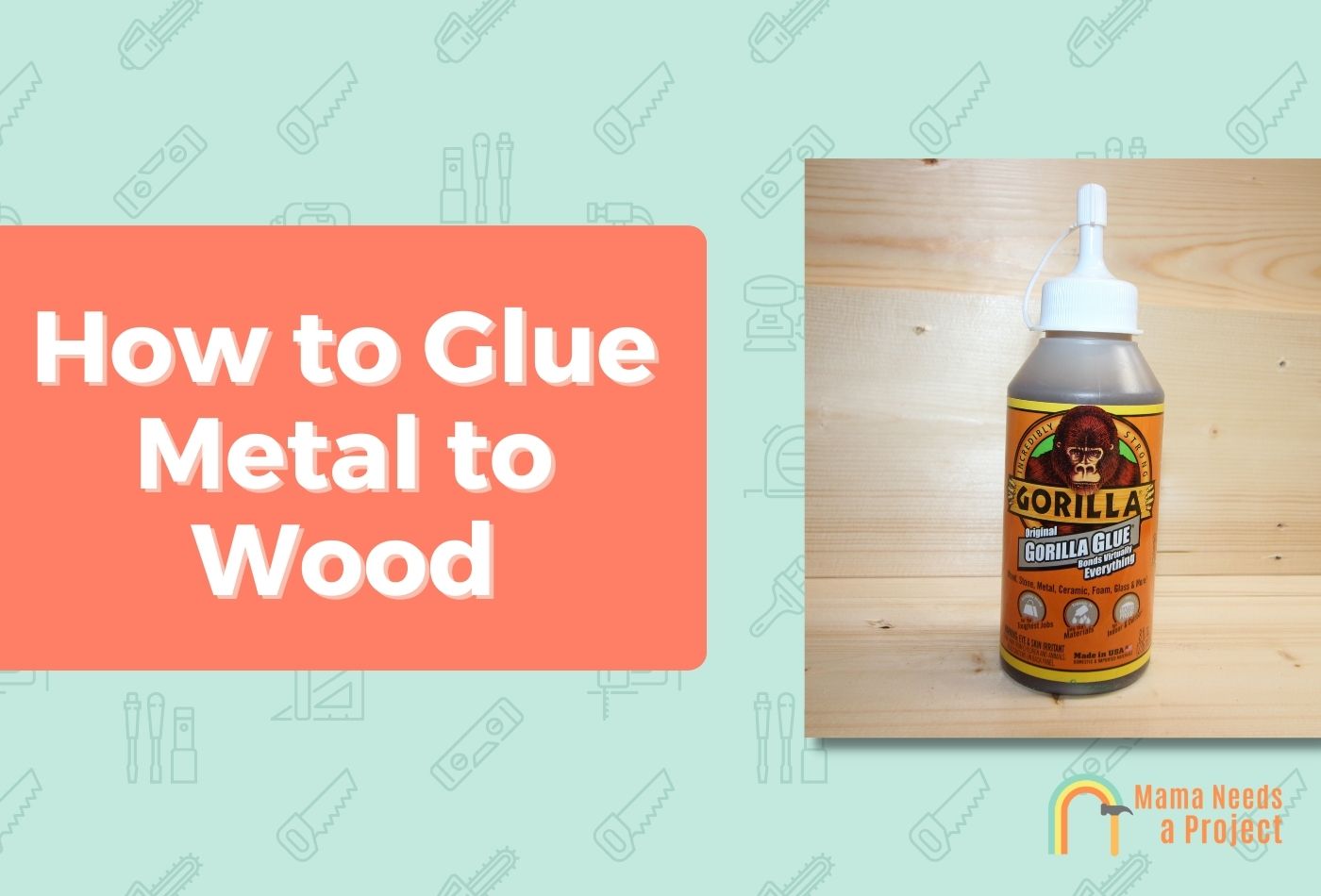How to Glue Metal to Wood (Best Glues to Use)
Are you looking to glue metal to wood?
It’s actually easier than you think if you use the right materials and follow a few easy steps.
In this guide, I’ll show you exactly how to glue wood to metal, the best glue for bonding wood to metal, and much more. Let’s dig in!
- Preparing your surfaces is one of the keys to creating a successful bond between metal and wood surfaces.
- Select the right glue for your project’s intended purpose, paying special attention to temperature and moisture resistance and the strength of the bond that you need.
How to Attach Metal to Wood: Step-by-Step Guide
Step 1: Gather Tools and Supplies
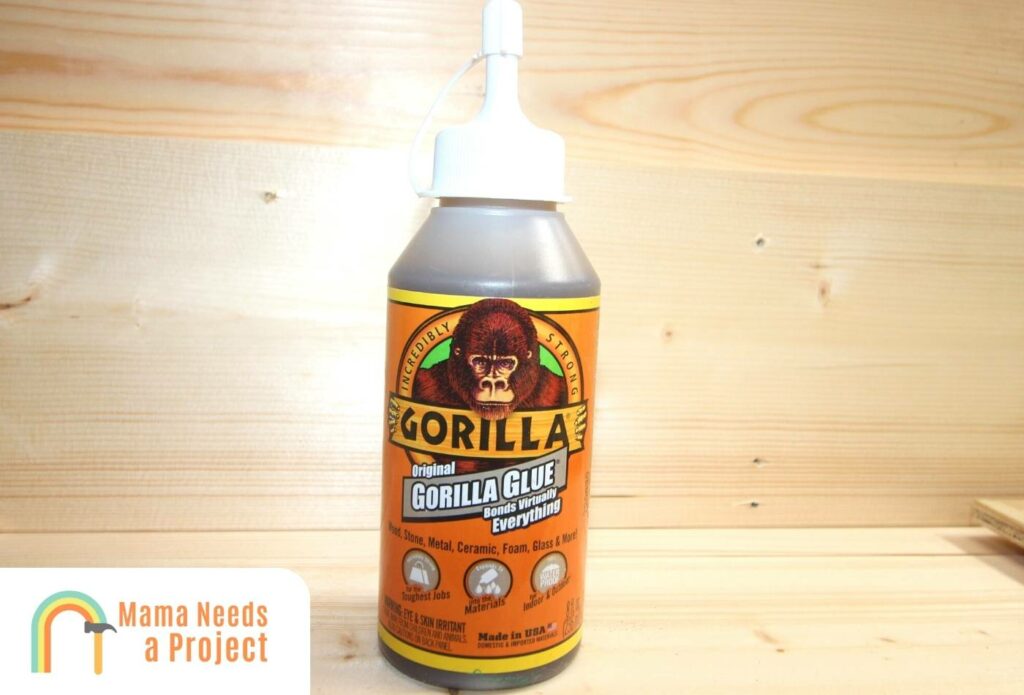
Before you begin any project, I always recommend gathering all of the tools and supplies you’ll need. Especially when working with different types of glue, because sometimes you have less than a minute to spread the glue and piece your project together.
I always recommend you read the manufacturer’s instructions when you’re using a new type of adhesive. There are many different types of glue, and they have different drying times and strengths. Sometimes, they require heat, moisture, or pressure activation for the best results, and it helps to know what you’re doing before you start.
Grab your favorite glue, your metal and wood, and let’s get started.
Tools and Supplies for Gluing Metal to Wood:
- A brush or small roller to spread the glue
- Dry rags and a damp cloth
- Tape Measure or ruler
- Marker
- Wire brush
- Sandpaper
- Clamps
- Heavy objects to use as weights
A Note About Safety:
You need to take proper safety precautions like wearing glasses when working with certain types of glues, especially cyanoacrylate, which can cause severe eye damage if you get it in your eyes.
Some types of glue will also melt latex gloves, so be sure to use rubber or nitrile gloves when working with adhesives. If you’re using a heavily solvent-based glue, be sure to wear a respirator.
Step 2: Prep the Surface
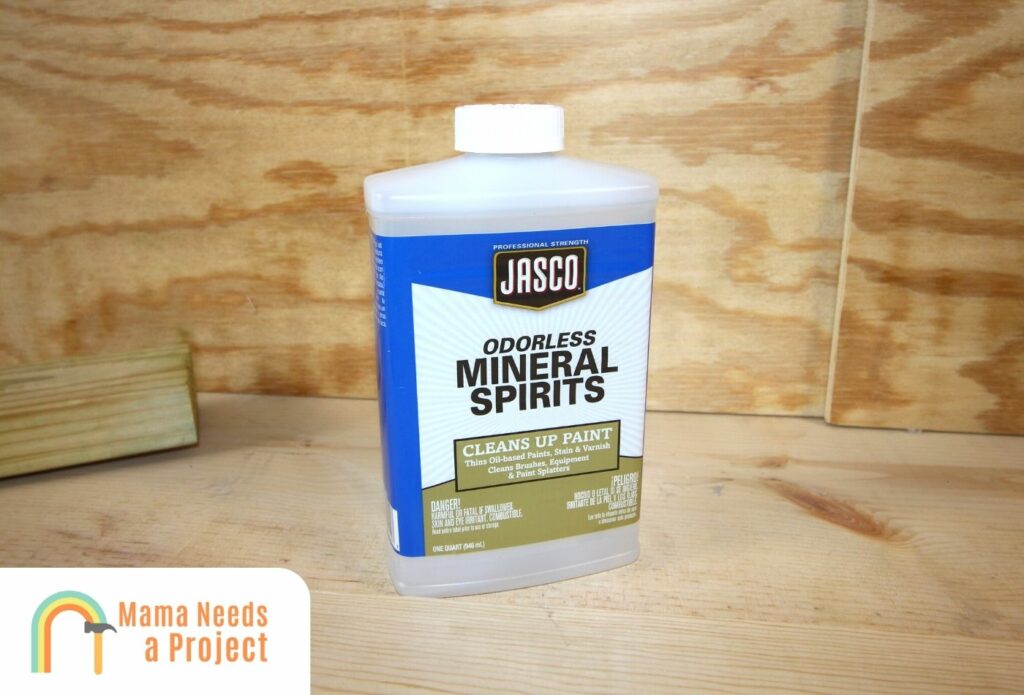
Any time you’re using glue on a project, you need to make sure your surfaces are clean and dry.
Prepare the metal by wiping it to remove oil residues, and use a wire brush to remove rust. Wipe it with a clean dry cloth and allow it to dry completely before applying any glue.
It’s critical that the wood surface is also completely dry and clean. You’ll get better adhesion if you have a rough surface scuffed with sandpaper or a wire brush. However, don’t leave any sawdust or debris on the surface. I recommend cleaning the wood with mineral spirits before applying any adhesive.
I’ve found that it makes it easier to avoid mistakes if you clearly mark the areas on each piece that will need glue.
Step 3: Apply Adhesive
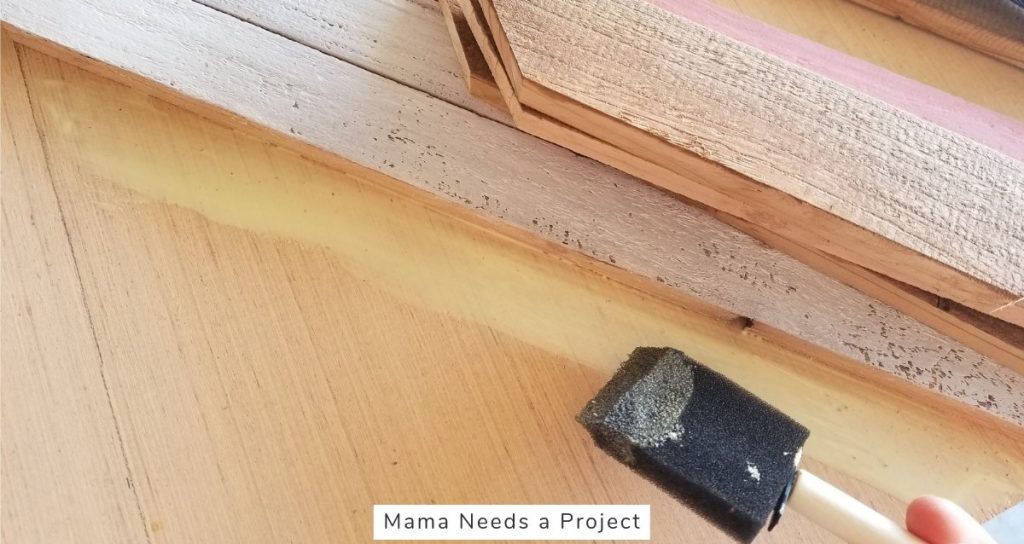
Once your surfaces are clean and dry, you can start applying your adhesive. With some types of glue, you need to work quickly so it doesn’t dry before you get your pieces together.
Glues can be applied in different ways. Most of the glues that work well for gluing wood to metal come with an applicator tip, and you don’t have to spread them out too much. You can use a thick bead, and when the two pieces are joined together, it provides excellent adhesion.
It’s important to note that some types of glue, like contact cement, require that both surfaces be covered with adhesive to get the proper bond.
You can also use a glue dispenser to make it easy to spread your wood glue on your wood surface.
Step 4: Press Metal and Wood Together
After the glue is applied, press the metal and wood together.
With fast-acting glues, which set in under a minute, you don’t have to use clamps or weights, but with epoxy adhesives, you should clamp your piece and leave it that way for at least 24 hours.
Once applied, you can wipe away any excess glue to keep your surfaces clean.
Step 5: Give it Time to Dry
As with using any glue, you need to give it time to dry before moving it around.
Drying time depends on several factors, including the temperature, humidity, the glue you’re using, and the type of metal and wood you’re joining together. Some glues can take less than an hour to dry while others might require a full 24 hours.
It can be hard to be patient, especially if you need your project to dry before you can move on to the next step, but it’s better to give it plenty of drying time so you don’t have to reglue it.
It’s also important to note the differences between drying time and curing time.
The curing process can take much longer than when your glue is dry to the touch. You can think of the curing process as when the glue has completely dried, not just dry to the touch. When this process is completed, your project will have its maximum strength possible. Specifically if you’re using an epoxy adhesive, you’ll want to ensure your glue has cured before applying pressure to your project.
Best Glues to Glue Metal to Wood
These are my favorite glues for gluing metal to wood. When you’re looking for a permanent bond for gluing metal to porous surfaces like wood, give these adhesives a try.
1. Gorilla Glue

Gorilla brand makes several different types of adhesives, including superglues and epoxies. One of my favorites, however, is Original Gorilla Glue. It’s a polyurethane adhesive that’s moisture-activated, so you must apply a small amount of moisture to one surface for it to work.
Original Gorilla Glue has a quick set time and it’s industrial strength. It will create an incredibly strong with almost any type of material.
Of all the household superglues, Gorilla Glue holds up to the widest range of temperatures. It’s able to withstand temperatures as low as -65°F (-54°C) and as high as 220°F (104°C) without breaking down.
One of the things I like most about this glue is that it is packaged in many different sizes, from 3 grams to 36 ounces, making it my top choice for large projects. Plus, it expands when you use it, so a little bit goes farther than you think.
Pros
- Fills gaps and voids by expanding
- Waterproof
- Good for extreme temperatures
- High strength bond
- Ideal for large surfaces and outdoor projects
Cons
- Hard to get off your hands
- The expansive nature makes precise application difficult
- Dangerous for children because of the damage it can cause when it expands in airways
- ORIGINAL GORILLA GLUE: The water activated polyurethane formula expands into materials to form an incredibly…
- 100% WATERPROOF: Doesn’t break down when exposed to outdoor elements
- VERSATILE: Easily bonds wood, stone, metal, ceramic, foam, glass, concrete and much more
2. Loctite Super Glue Ultra Gel Control
Loctite brand makes some excellent adhesive products, and when you’re looking for an inexpensive fix for gluing metal to wood, this is a good choice. The Loctite Super Glue Ultra Gel Control adhesive is their most durable and flexible cyanoacrylate-based adhesive.
For superior strength and durability, Loctite Ultra Gel superglue is a good choice because it resists water, shock, and vibration. It also sets instantly, so you can use it without having to clamp your projects together, and it dries clear for no mess or fuss.
The rubber-toughened formula of Loctite Ultra Gel can withstand temperatures between -65° and 180°F (-54° to 82°C), making it a good choice for outdoor use. It’s also a top choice for projects that require a flexible bond.
Pros
- Patented side squeeze container works well for vertical applications
- No drip or run formula
- Invisible repairs
- Water and solvent-resistant
- Anti-clog cap allows for storage of leftover glue
Cons
- Small packaging doesn’t contain enough glue for large projects
- Rubber Toughened: Loctite’s most durable cyanoacrylate super glue formula resists water, impact, shock,…
- No Drip or Run: No-mess formula is ideal for vertical applications and does not drip or run
- Maximum Control: Features a patented easy side-squeeze bottle design for Maximum control and pinpoint accuracy…
3. J-B Weld Kwikweld
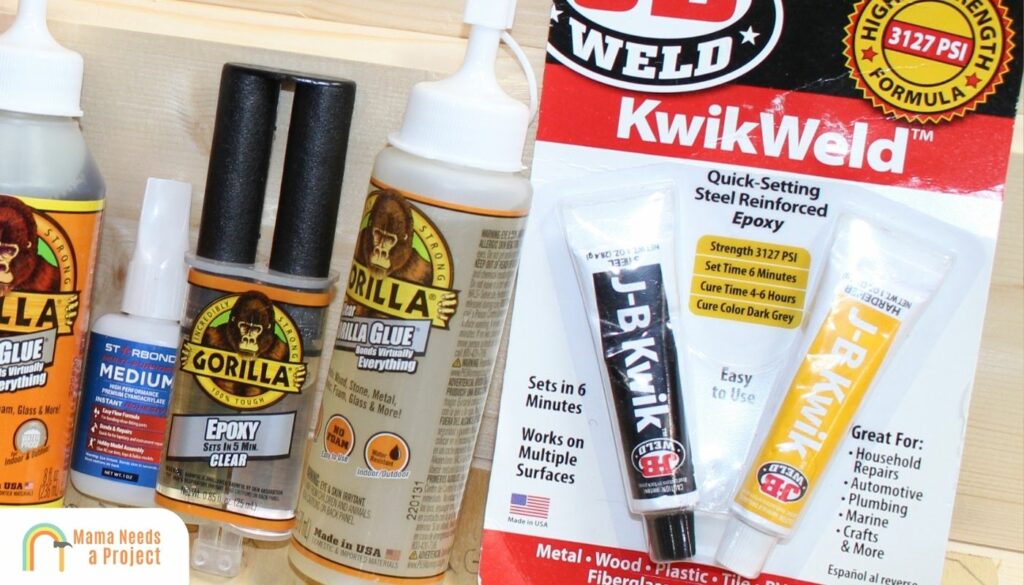
When you’re looking for a great value-to-dollar ratio, J-B Weld Kwikweld is a great choice. People have been using J-B for decades. My dad was a mechanic, and he used J-B Weld to repair everything.
J-B Weld makes a lot of different epoxy products, and when you’re gluing metal to wood, you want to look for the Kwikweld manufacturer part 8276. It comes in a couple of different sizes, and the tubes are resealable so that you can save the leftovers for later.
J-B Weld Kwikweld is mixed in a 1:1 ratio, so it’s not complicated to mix, but it can be a little messy. Pour two equal-sized amounts on a piece of cardboard and use a small piece of wood to mix them together.
Kwikweld dries dark gray, so be careful when you apply it if the appearance of your project is important. It takes six minutes to set, so you have time to reposition your project pieces, but you still need to make sure they are clamped together tightly until it’s cured, which takes about six hours.
Pros
- Rated for high temperatures
- Has a tensile strength of 3127 pounds
- Cures in 4 to 6 hours, much faster than other epoxies
- Waterproof
Cons
- Mixing by hand can be a little messy
- Be careful about squeezing the tube because it can blow out the rear, and once the seal is broken, you have to use it or throw it away
- J-B Weld Kwikweld: A Fast Setting Version Of The Original Cold Weld Two-Part Epoxy System That Provides…
- Cure And Set Time: After Mixing The Tubes At A 1: 1 Ratio, It Takes 6 Minutes To Set And 4-6 Hours To Cure….
- Versatile And Dependable: J-B Weld Kwikweld Is Steel Reinforced, Has A Tensile Strength Of 3127 Psi And Can…
4. Gorilla 2 Part Epoxy
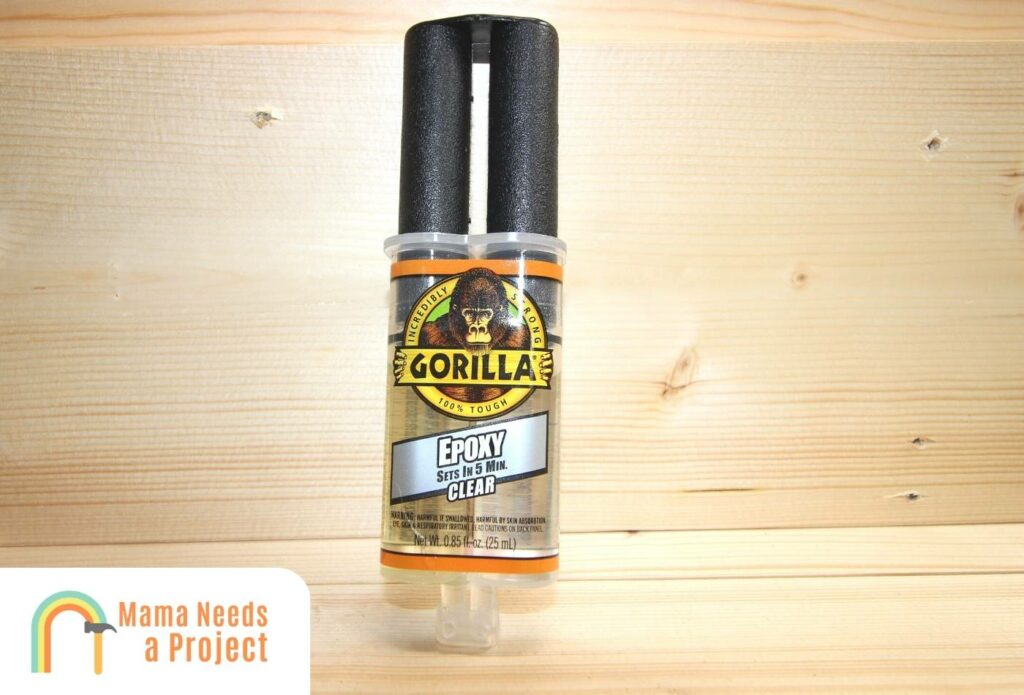
There’s a lot to love about Gorilla 2 Part Epoxy adhesive. It’s easy to use because the components are in two separate barrels with an easy-to-use syringe. It takes all the mess and guesswork out of mixing epoxy, but you still get the same great benefits.
Gorilla 2 Part Epoxy dries clear, and it works for bonding a variety of materials, including metal, wood, plastics, ceramics, and glass.
With a 5-minute set time, you still have plenty of room for repositioning, which is important if you’re working on a complicated project.
For best results, use Gorilla 2 Part Epoxy between 50° to 100°F (10°C to 38°C). It may take some time to harden completely, and it won’t be sandable until completely dry.
Pros
- Rated for both indoor and outdoor use
- Dries clear for a spotless finish
- Works on many different types of materials
- Fills gaps and voids
- Fast setting
Cons
- Moderate resistance to water
- Only effective for specific metal types, such as metal and aluminum
- Not the best solution for large projects
- The packaging doesn’t allow you to save the leftover glue
- Strong, permanent, fast and gap-filling; Great for multiple surface applications
- Best for tough repairs requiring a durable bond, gap-filling and solvent resistance
- Dries clear; Ideal for clean, easy finishing
Troubleshooting Wood to Metal Adhesives
Gluing metal to wood is one of the most challenging adhesive questions you’ll face as a woodworker and DIY enthusiast. Trust me, I’ve had my fair share of problems with gluing wood to metal!
If you find yourself back at the drawing board, use this troubleshooting guide to help you figure out what went wrong.
Problems You May Encounter
Wood expands and contracts at a different rate than metals do. While metals expand and contract due to heat and cold, they are less likely to expand and contract due to moisture, which wood is prone to do.
This expansion and contraction can make the two materials separate if the glue isn’t flexible enough to maintain the bond. If you’re working on a project for outdoor use, choose a flexible product rated for moisture resistance.
When gluing metal to wood surfaces like MDF and particle board, the glue will soak into the top layer, resulting in poor adhesion. If you seal the wood product first, you’ll have more success.
When applying adhesives, it’s best to work indoors at room temperature. If you’re using an adhesive with a low initial grab, make sure you can clamp the two pieces together for at least 24 hours to achieve maximum adhesion. Then, give your project plenty of time to cure.
Troubleshooting Epoxy Adhesive Cures
One of the most common problems that people run into with epoxy adhesives is the mixing of separate components. If your measurements were off when you mixed the two parts of the epoxy together, it can result in a poor bond or complete failure of adhesion.
Some epoxy adhesives come in kits, so there’s no measurement required. However, you still need to be careful to mix the two components together thoroughly.
Epoxy adhesives form incredibly strong bonds, but they aren’t flexible, so these adhesives become weaker over time when they are used to bond metal to wood.
Another problem with epoxy is that it has little initial adhesion, and it takes time to cure. Until it sets, you need to keep your pieces clamped together or firmly weighted.
Troubleshooting Mastic Adhesives
Mastics like Liquid Nails are common construction adhesives that are amazing products, but when gluing metal to wood, you can run into many of the same problems as when using other epoxy resin adhesives.
Mastic adhesives aren’t waterproof, so they aren’t rated for outdoor equipment and use. They also have a low initial grab, and they aren’t flexible enough to handle the expansion and contraction of metal and wood under many conditions.
Troubleshooting Contact Adhesives
Another glue with low initial adhesion is contact cement. Contact adhesives work great for many applications, but unless you’re working with large sheets of metal and wood that will be indoors and not subject to wide variations in temperature and humidity, you could run into some problems.
Contact adhesives are another glue that will soak into particle board and MDF, so be sure to use a sealant on those surfaces before applying contact cement.
Factors to Consider When Selecting the Best Adhesive
With some projects, gluing metal to wood isn’t a big deal. But in some cases, you need superior strength and weather resistance. Understand the needs of your project before you choose your metal glue first, then find a glue that matches what you need.
Strength and Durability
Finding the best adhesive for metal to wood depends on how strong the bond needs to be. Some projects don’t have that much stress on them, but if your project is under constant stress, you need the strongest adhesive you can find, like a polyurethane adhesive such as Original Gorilla Glue.
Product Compatibility
There are a lot of different types of glues out there! Always check the one you’re purchasing for material compatibility.
For example, J-B Weld makes a lot of different epoxy adhesives, but the best one for gluing metal to wood is the Kwikweld, part number 8276. If you get the one just for metal, it won’t work on your metal-to-wood project.
Need to attach leather to wood? Check out this guide for gluing leather to wood for more help!
Flexibility
If your project will be subjected to things like movement, vibrations, and repeated expansion and contraction, it needs to be flexible. The most flexible glues are contact adhesives and cured polyurethane adhesives, like Original Gorilla Glue.
For permanent bonds that don’t require a lot of flexibility, epoxy adhesives are a good choice, but they become brittle over time if there’s a lot of movement.
Here’s a great video explaining how to bond wood with metal or steel!
Weather and Temperature Resistance
When choosing a glue, you need to know what kind of weather and temperature resistance it has. Most glues are fine if you’re using them on indoor projects, but if you are working on an outdoor project, you need to consider the temperature extremes it will be up against.
You should also know how well the glue you’re using holds up to moisture. Is the glue you’re using waterproof or moisture-resistant? Some types of glue, like mastic adhesives, can’t be used around water at all.
Final Thoughts
Attaching wood to metal is easier than you think if you use the correct glue and follow a few simple steps.
It’s critical to make sure that your metal surface is completely clean and oil free to ensure a durable bond that will last.
The best glue to bond wood to metal that I recommend is an either an epoxy glue, super glue, or polyurethane glue. These will give you the strongest bond that are great at bonding metal surfaces to wood. I don’t recommend using an ordinary wood glue as you won’t get nearly as strong of a bond.


